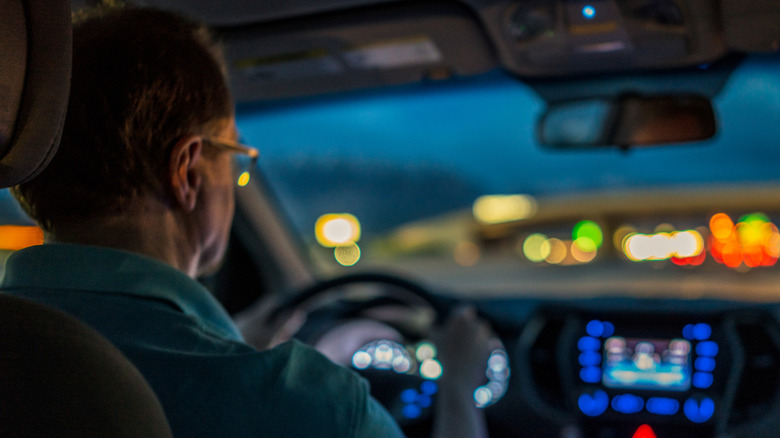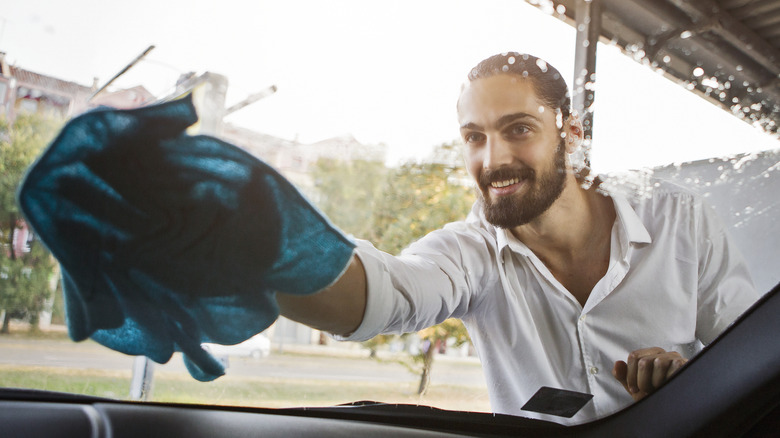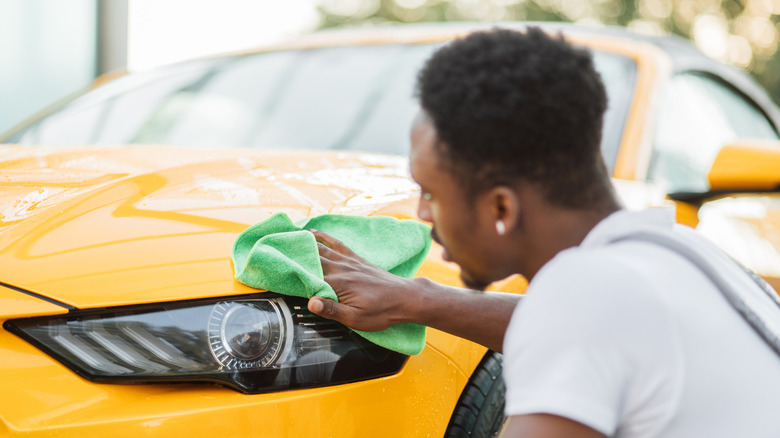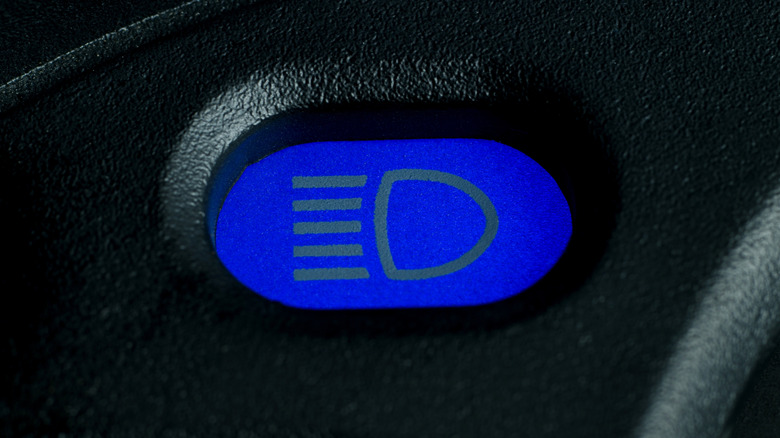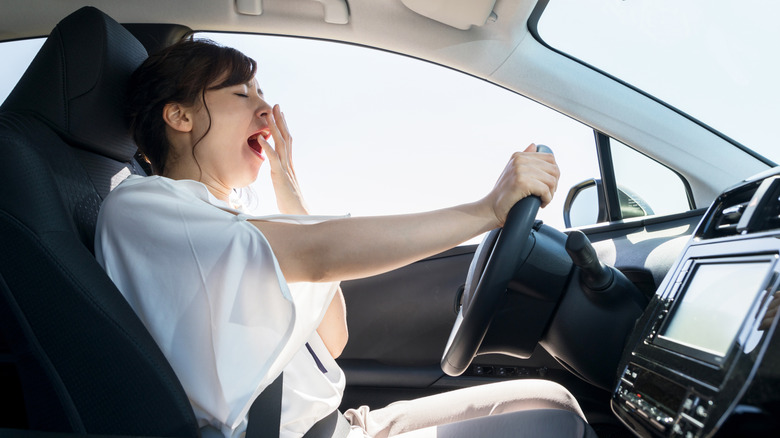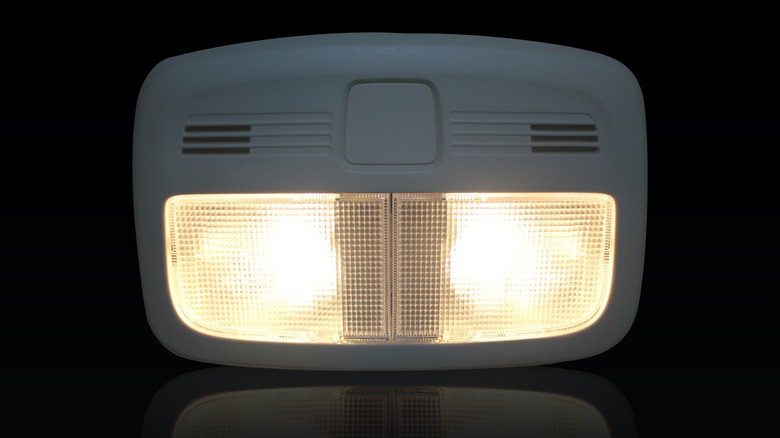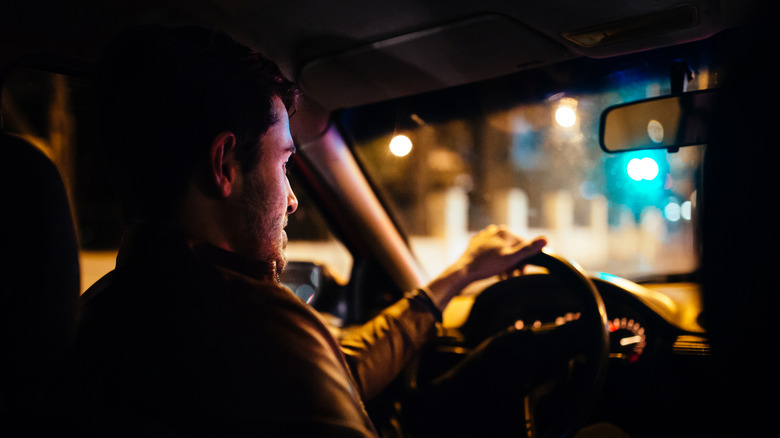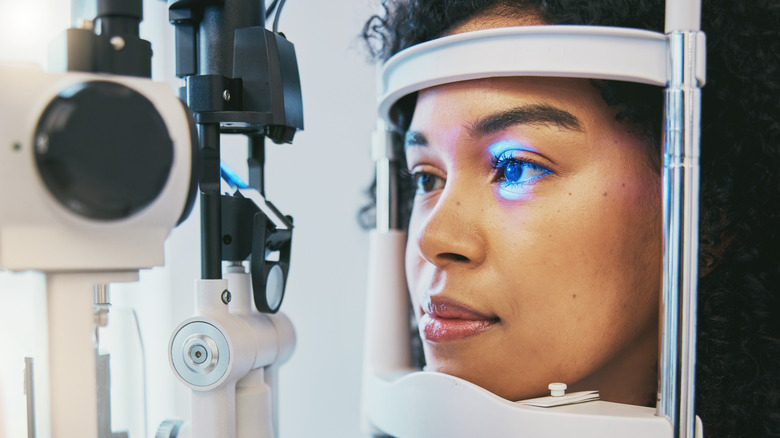7 Ways To Improve Visibility When Driving At Night
If you regularly drive home at night on the highway, there's a likely chance you've come across a good few accidents on the side of the road. While may feel that you see an unusual amount of these accidents at night, it's sadly not as uncommon an occurrence as you might assume. In general, drivers are at higher risk of getting into a wreck at night. In 2020 alone, the National Highway Traffic Safety Administration reported that 29% of the over 5 million car accidents from that year took place at night with nearly half of those crashes resulting in fatalities.
Sadly, for as advanced a species as the human race is, our natural eyesight at nighttime remains very weak. So as you can imagine, our visibility is significantly compromised while driving at night, making it harder to judge space and speed compared to when we're on the move during the day. Combined with the increased levels of drowsiness that typically sets in once the sun goes down, and it's easy to see why such a high number of car accidents occur during this time.
For the safety of yourself and others on the road, it's your responsibility to take every step necessary to prevent an accident from occurring. What works for everyone individually will differ, but a general combination of keeping your car maintained, driving under the right conditions, and staying extra vigilant while on the road will make a world of difference whenever driving at night. With that out of the way, here are seven safety tips to improve your visibility while driving at night.
Keep your windshield clean
As we stated previously, our visibility is extremely limited at night, so it's important to do whatever is necessary to increase your ability to see. Your windshield is the first line of defense in this instance. During the day, it may be easy to underestimate or not notice the many smudges and stains that populate your windshield. But when the lights go out, these obstructions can spell serious trouble.
The dirt and debris on your windshield can disperse the light which causes an increased amount of glare and distortion. Even certain windshield treatments such as rain repellent has the potential to cause such issues. So before driving out at night, pay extra attention to your windshield. Make sure your windshield wipers are regularly replaced and maintained as they will wear out over time and cause even more streaking. Even if your wipers are at their best, it's a good idea to regularly clean and maintain the outside of your windshield and investing in products that will help you do so. Likewise, the inside of your windshield will also require regular cleaning to prevent the buildup of film and residue. And of course, if any cracks or splits show up on your windshield, you should immediately get it looked at by a professional.
Regularly clean and maintain your headlights
Next to our windshields, headlights are perhaps the most important component of your car when driving at night. No matter how many street lights there are in the area you're driving around in, nothing will give you the immediate visibility that a pair of properly working car headlights will. And just like every portion of your car, keeping your headlights well-maintained will go a long way in ensuring their longevity, let alone your safety while driving at night.
Even if it may not be as apparent as other portions of your car, your headlights get dirty very easily and will need regular cleaning to maintain their sheen. There are many methods to go about this from commercial products such as headlight wipes and WD-40 to homemade solutions such as lemon and baking soda. Whether you choose one of these techniques or go about getting help from a full-on professional source, making sure that your headphones are clean and clear will go a long way into ensuring your visibility at night.
Of course, just like the lights in your home, you'll also have to change out your headlights every now and again when they show signs of dimming or misalignment. On top of the safety concerns this brings to you, there's also the risk at being pulled over by law enforcement when your headlights go out, as this is a serious public safety concern.
Only use your high beams when truly necessary
When its super dark outside, it may be tempting to use your high beams while driving. Sure, these highly powered lights were made for a reason, but only in very specific circumstances. When used in the wrong situation, high beam lights can be a danger to you and others on the road.
Anyone who's been in the line of sight of a pair of blaring high beam lights knows just how irritating they can be. These bright bold lights can temporarily blind other drivers who see them and increase their chances of getting into an accident. Along with the danger this can bring, having your high beams on when you're a certain distance away from other cars can get you into legal trouble in some states such as Florida and California.
So when is the right time to turn on your high beams? As a rule of thumb, the only time you should use your high beams are on wide long stretches of empty road, such as driving through rural areas that may not have many street lights. Avoid using them while on the highway or in cities at all costs, as well as when it's rainy or foggy outside and instead use your regular headlights.
Don't drive while you're tired
Humans are diurnal by nature, meaning we're hard wired to be active during the day and go to sleep at night. Sure, there are some who like to consider themselves night owls, but as a whole most of us operate best when the sun is out, which can spell bad news for people driving at night.
The dangers of getting drowsy behind the wheel should be obvious but not underestimated. The AAA Foundation for Traffic Safety estimates that nearly 330,000 annual car crashes are the result of fatigued drivers while the National Highway Traffic Safety Administration estimates that such incidents costs $109 billion every year. Sleep deprivation can have a negative impact on your eyesight, making your vision blurry and your eyes more sensitive to the light, which are two big things you don't want while trying to navigate on the road. On top of this, being tired will greatly cut down on your vigilance and judgment skills.
Getting an adequate amount of sleep every night is a good overall preventive measure, but if you do find yourself getting sleepy on the road, it's best to not try fighting it. Find somewhere to safely pull over and take a power nap. If you're in a pinch time wise, take a short walk and have some coffee or water to refuel yourself. When getting back on the road, drive with the windows down to stay awake.
Keep your cabin lights off
At first glance, it may seem like a good idea to have your car's interior lights on while driving at night. Not only will it help you see the inside of your car better, but the light will help keep you awake. However, these assumptions are among the reasons why you should avoid having these lights in such a scenario.
Your car's cabin lights can prove to be a surprisingly distracting element when turned on at night. With such strong lights pouring into every corner of your car, your attention will be taken away from the truly important lights you should be looking at on the road. Even worse is that the lights being on in your car can create a dangerous mirror effect that will make the outside seem completely dark, making it near impossible to see through the windshield or windows. And suddenly turning the lights off can create temporary blindness as your eyes take time to adjust to the dark. Even the lights on your speedometer and similar components can prove to be a dangerous distraction if they're too bright.
Simply put, unless you or someone in the car truly needs to use them to read something important or search for an item that fell, you should not have your cabin lights on while driving whatsoever. Similarly, any lights that do need to be on such as your speedometer should be dimmed to a level that you can read without being abrasive.
Slow down when you need to
The moral of the classic Aesop fable "The Tortoise and the Hare" that slow and steady wins the race is a timeless one that applies to countless scenarios. It is certainly a saying that nighttime drivers should abide by, as moving through the streets at night with extreme speed is a good way to end up in bad shape.
Speeding up can be a dangerous choice that can greatly hamper your visibility while on the road. Our eyes can take hours to fully adjust to the dark even in the best of situations and so moving at high speeds will only make your eyes work harder to spot obstructions on the road. This and the delayed reaction times common in nighttime drivers means that any potential hazards. Even if the street you're driving down doesn't have a lot of traffic at night, speeding means you could miss an animal, pedestrian, or other road obstruction and have a collision. Likewise, you risk missing important traffic signals that can put you in danger or get you a hefty ticket.
Try leaving as early as possible if you know you'll be driving at night in order to give yourself plenty of time to drive steadily. Always abide by the classic driving practice of staying at least three seconds behind any car you're tailing. If you're moving through rain, fog, or snow, you'll need to drive with even more extreme caution and attention.
Get your eyes looked at
At the end of the day, even after doing all you can to stay vigilant, steady, and distraction-free, you may still find yourself struggling to see the road at night. Persisting issues such as this should be a sign that you might need glasses when you're driving and to get your eyes checked out by a professional.
Ideally, your doctor should be performing eye tests during your regularly scheduled annual exam to give you a good idea as to where your vision is, as well your problems are linked to even greater health concerns. For more advanced concerns, you should have your eyes looked at by an optometrist who will be able to give you a prescription to glasses that work best for you. There are also non-prescription options such as glare-reducing night driving glasses. Whatever kind of glasses you go for, be sure they don't disrupt your line of sight in any way and that you keep them clean and free of smudges.
Even if you don't need glasses, there can still improve your nighttime vision by practicing some healthy habits. A healthy diet consisting of foods high in vitamin A such as carrots, kale, pumpkin, spinach, eggs, sweet potatoes, beef liver, cantaloupe, and milk can significantly boost your eyesight. Additionally, switching to dark mode on your devices even during the day can prove to be beneficial to protecting your eyes.
